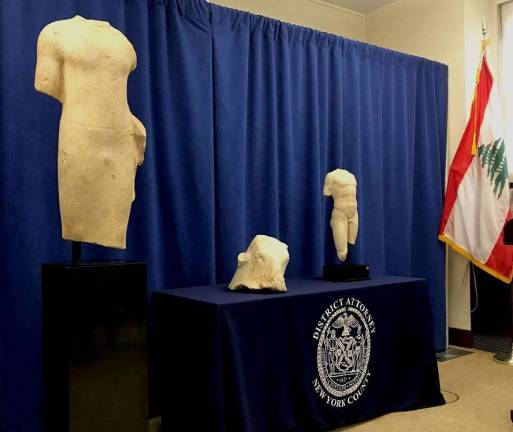Recovering Stolen History

When one thinks of hotbeds of criminal activity in Manhattan, the tony stretches of the Upper East Side are not the locale that immediately comes to mind.
But in recent years, the high-end storefronts, venerable museums and multimillion-dollar homes of the city’s Silk Stocking District have become the frontlines of a law enforcement crackdown that has prompted coordination between local, federal and international agencies, and, last month, the formation of a specialized unit within the Manhattan District Attorney’s Office.
The target of these efforts? Illegal trafficking — not of humans or drugs or stolen consumer goods, but of looted antiquities.
The East Side’s concentration of galleries, dealers, auction houses, museums and ultra-wealthy collectors has long made the neighborhood a nexus of the international antiquities trade, a lucrative category of ancient artwork that despite tight regulation has proven susceptible to illegal activity.
In the last year, authorities conducted high-profile seizures of a number of illicit antiquities that made their way from far-flung lands to the Upper East Side, sometimes after spending decades on the black market and moving illegally across continents through international smuggling networks.
Objects targeted by prosecutors have included an ancient Persian limestone relief recovered during an art fair at the Park Avenue Armory, a remnant of mosaic tile that once adorned a ship owned by the Roman emperor Caligula and was found in an antique dealer’s Park Avenue apartment, and, in early January, a number of Greek and Roman artifacts seized from the Fifth Avenue residence of hedge fund billionaire Michael Steinhardt.
Looted artworks have even turned up in the city’s most prestigious cultural institutions. In July 2017, the Metropolitan Museum of Art surrendered a marble bull’s head dated to 360 B.C. that was on loan to the museum from Steinhardt’s personal collection.
According to prosecutors, the bull’s head was excavated from the Temple of Eshmun in Sidon, Lebanon, in 1967, but was subsequently stolen in 1981 by a paramilitary group during the Lebanese Civil War. The artifact was illegally exported from Lebanon at an unknown date and eventually ended up in the hands of private collectors in Colorado who prosecutors say had scant documentation regarding the piece’s prior ownership.
Steinhardt, a prominent patron of the Met for whom an ancient Greek gallery in the museum is named, purchased the piece from the Colorado-based collectors in 2010 for $700,000 and loaned it to the museum. Soon after, Met officials alerted the Lebanese government that they had come to believe that the bull’s head was looted from the Temple of Eshmun site, starting a process that culminated in a ceremony last month marking the repatriation to Lebanon of the bull’s head and two other statues from the same site valued at over $5 million total.
“These pieces followed the same path that many pieces follow,” Assistant District Attorney Matthew Bogdanos said at the ceremony. “They leave a war-torn area or an area that is undergoing civil war or civil strife, they get in the hands of dealers who are less than scrupulous in determining its origin, and then they make their way through auction houses and other dealers to New York.”
Bogdanos, a classics expert who is a key figure in the office’s antiquities enforcement efforts, gained first-hand knowledge of the opportunities conflicts present to traffickers as a colonel in the Marine Corps during the Iraq War, when he worked to recover artifacts looted from the country’s national museum in Baghdad during the 2003 U.S. invasion.
Though there have been no criminal charges filed against Steinhardt, and Bogdanos noted that no one suggests the Met acted improperly, prosecutors have criticized behavior on the part of collectors that amounts to willful ignorance of some objects’ hazy provenance.
“No longer may those who deal in antiquities — whether they are dealers, collectors, museums, or auction houses — turn a blind eye to the rampant looting of the world’s cultural heritage,” Bogdanos wrote in one recent court filing. “In New York, at least, they are legally required to engage in a reasonable inquiry into the true ownership history and provenance of antiquities.”
The Manhattan District Attorney’s office says it has recovered thousands of illicit antiquities with a market value exceeding $150 million since 2012, many of which have since been returned to the countries in which they were unearthed.
In December, Manhattan District Attorney Cyrus Vance announced the formation of a dedicated antiquities trafficking unit that will work with federal prosecutors and specialized teams within the FBI and Department of Homeland Security to recover illicit antiquities.
“The volume and pace of our work in this area has increased to the point where we actually need a unit fully staffed with investigators, analysts and lawyers to make sure that when we understand that trafficked, looted and stolen items are in our jurisdiction we can bring all of the resources of this office to bear to make sure that they can be returned,” Vance said.
Michael Garofalo: reporter@strausnews.com